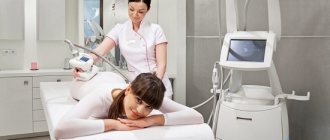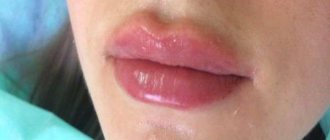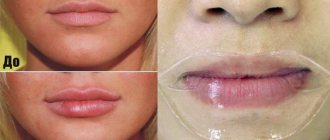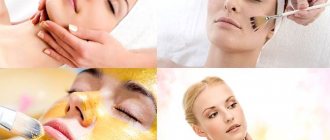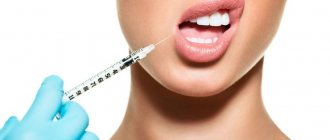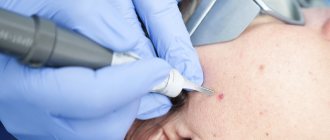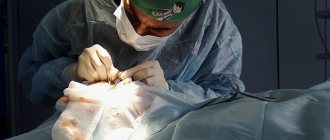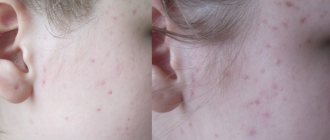- What is carboxytherapy
- Story
- Properties of CO2 in the body
- Mechanism of action
- Kinds
- Indications
- Contraindications
- Execution technique
- Device requirements
- The phenomena of “gas” beauty injections
- Recommendations
- How long does the course last?
- For what age
- Combination with procedures
- Clinical examples
- Pros of carboxytherapy
- conclusions
Carbon dioxide is the basis of all life on Earth and a necessary component of metabolic processes in the body.
Over time, the supply of oxygen to tissues, which is closely related to carbon dioxide, deteriorates, and metabolic disorders occur. To solve problems of general and local healing, carboxytherapy has been used for many centuries, which has proven itself in therapy and aesthetic medicine. The technique is a non-surgical and effective way to naturally restore cellular resources, which combines the interaction of mechanical, chemical and temperature factors to preserve beauty and health.
Story
460-370 BC, Ancient Greece - Hippocrates prescribed baths in carbon dioxide springs and dosed drinking to treat dermatological lesions.
1777 - Becher explained the positive effects of gas on the body.
XVII-XVIII centuries. - Robert Boyle, Antoine Lavoisier established the bactericidal properties of carbon dioxide.
1932 - the first introduction of carbon dioxide at a balneological resort for the treatment of joint and cardiovascular diseases.
1995 - The beginning of the aesthetic use of carbon dioxide.
2006 - creation of a separate course on cosmetological carboxytherapy at the University of Siena.
Properties of CO2 in the body
- Carbon dioxide is a colorless gas with two oxygen atoms and one carbon atom, odorless, one and a half times heavier than air.
- It is a normal component of the atmosphere, where it is detected in minimal quantities in the air, and in sufficient quantities in mineral water.
- It appears as the end product of biological processes: respiration, fermentation or as a result of the combustion of coal fuel.
- It has increased solubility compared to oxygen.
- Produced by cells, maintains acid-base balance and affects protein formation, cell membrane permeability, hormone synthesis and the state of the nervous, hematopoietic, and excretory systems.
- The body contains 7% CO2, which is produced in the amount of 1 kg per day and is an internal product of metabolic processes.
- It is also found in a dissolved state in blood cells - erythrocytes in the form of carbonic acid salts.
- It is distributed through the venous system and exhaled by the lungs, where the concentration of the component decreases while controlling the body's defenses.
- It is interconnected as a result of transport by hemoglobin with oxygen, with which it is in a 3:1 ratio, which creates normal conditions for the life of the body.
- When used medically, it is absorbed into the body and eliminated after 30 minutes, therefore it is absolutely and naturally safe.
Mechanism of action
- When carbon dioxide is supplied under pressure, unstable carbonic acid dissociates into ions after combining the substance with water, which leads to a decrease in pH, lipid oxidation, and activation of lymph and blood circulation.
- With the tissue distribution of carbon dioxide, capillaries expand, artificial signaling systems of “oxygen starvation” are activated, and local temperature increases, which improves trophism and general immunity.
- CO2 is a strong vasodilator that regulates blood flow and relaxes muscle cells. Normally, the partial pressure of carbon dioxide in the blood is 40 mmHg. When it increases, the flow of oxygen increases and microcirculation is stimulated.
- The substance saturates tissues with oxygen, which enhances regeneration, recovery and provides antispasmodic and analgesic effects.
- An increase in gas exchange promotes the release of oxygen from hemoglobin, its active entry into tissues and the activation of energy resources - the Verigo-Bohr effect.
Advantages of the Reabox device
Reabox was created by Russian scientists and has been widely used since 1985.
Baths performed using this device have the same healing effect as water baths. It should be borne in mind that they are tolerated more easily by patients due to the lack of stress that water directly exerts when taking such a procedure. Such dry baths act directly on the skin, accelerating the body’s absorption of gas significantly.
This treatment unit is protected by a patent and is a box made of acrylic glass. The box closes hermetically, completely covering the body, leaving an opening for the patient's head. A soft cuff around the neck provides a tight seal and prevents the patient from inhaling gas.
The installation is automated: it maintains the required gas concentration and humidity level. Carbon dioxide, penetrating through the patient's skin, dilates blood vessels and capillaries, which leads to an increase in blood flow. The absence of inhalation gas into the body ensures a long-term effect on blood vessels and nerve endings.
Thus, today, treatment using dry carbon dioxide baths is unique and very effective in treating a number of diseases.
Kinds
Non-invasive carboxytherapy is a transdermal method of saturating the skin with carbon dioxide using special means - a mask with the main component - a carbon dioxide molecule and additional substances: hyaluronic, fruit acids, vitamins, plant extracts to increase nutrition and hydration of cells. The technique does not damage the barrier functions of the skin and does not injure soft tissues. It is rarely used, as it has a low speed of manifestation of the result and a small severity of the impact.
Invasive carboxytherapy is the intra- and subcutaneous injection of carbon dioxide using a special device with thin needles for renewing and rejuvenating effects. Manipulation is popular as it provides long-lasting healing results and rapid delivery of gas to the points of influence.
The essence of the method
Degenerative-dystrophic changes in cartilage tissue and vertebrae provoke pain. Typically, pathological changes occur due to hypoxia (lack of oxygen), as well as a deficiency of nutrients in tissues due to excessive stress or metabolic disorders. As a result, the muscles become denser, tense, spasms and painful sensations occur.
Pneumopuncture for the back and joints is a new treatment method using carbon dioxide. During the procedure, the doctor injects a substance into the joints or muscles of the back near the spine using a special device. After the injection, capillaries expand, blood flow increases, and metabolism accelerates.
Reference. Even after the first session of carboxytherapy, the functionality of the body increases, cells and tissues are saturated with nutrients, pain and spasm disappear, and immune defense is activated.
Weakened cartilage, blood vessels, and nerve processes are supplied with oxygen, and the symptoms of degenerative disorders become less pronounced. After the procedure, the development of pathology slows down.
Gas injections are most often not dangerous to health, since a minimal amount of carbon dioxide is introduced into the body. In addition, the substance is eliminated within 5 to 10 minutes.
Carboxytherapy is carried out using a medical gun. Many domestic clinics use devices that are made in France or Germany.
This device is equipped with a reservoir that is designed to introduce carbon dioxide. Don’t worry, a purified substance is used during the session, which is confirmed by quality certificates.
Indications
- Prevention of premature age-related changes.
- Chrono-, photoaging with signs of wilting, wrinkles, decreased elasticity.
- Oily, porous skin with acne and post-acne manifestations.
- Correction of the periorbital zone: “bags”, “dark circles” under the eyes, drooping upper eyelids, “crow’s feet”.
- Folds in the neckline, upper lip - “purse-string wrinkles”, neck - “rings of Venus”.
- Dry, thin, flabby skin of the face, body, back of the hands.
- Hyperpigmentation and uneven color of the epidermis.
- Local pastosity, atonicity and swelling of tissues.
- Pronounced “vascular pattern” and telangiectasia.
- Subcutaneous accumulations of fat in the submental area - a “double” chin.
- Lipomatosis is a limited proliferation of lipid tissue.
- Cellulite and local fat deposits in the abdomen, thighs, buttocks, upper and lower extremities.
- Stretch marks - stretch marks, scars, including keloids.
- Restoring shape after childbirth, sudden weight loss.
- Hair loss, dullness.
- Skin dermatoses - psoriasis, eczema.
- Trophic ulcers and difficult-to-heal wounds as part of complex therapy.
- Preparation or rehabilitation before and after plastic surgery, liposuction, burns, injuries.
- Treatment of medical diseases in various fields: neurology, cardiology, endocrinology, traumatology.
Contraindications
- Pregnancy, lactation.
- Viral and infectious processes: pustular lesions, herpes.
- Increased body temperature.
- Severe damage to the cardiovascular and respiratory systems.
- Chronic renal and liver failure.
- Severe abdominal obesity - with a BMI over 30.
- Blood clotting disorders and taking anticoagulants, antiplatelet agents.
- Malignant and multiple benign neoplasms.
- Acute thrombophlebitis, phlebothrombosis.
- Epilepsy.
- Tuberculosis.
- Individual intolerance.
Indications for pneumopuncture
Gas injections are used to treat osteochondrosis at any stage, especially during the weakening of the symptoms of a chronic disease. In severe forms of pathology, which is accompanied by a bulging intervertebral disc or intervertebral herniation, this technique is also effective.
Pneumopuncture is indicated for arthritis
Carboxytherapy is used for the following diseases of the musculoskeletal system:
- Arthritis.
- Arthrosis.
- Rheumatic diseases.
- Inflammatory or dystrophic lesions of periarticular structures.
- Constant pain in the muscles or joints.
- Headache, dizziness with cervical osteochondrosis.
- Gout.
- Bone disease due to calcium deficiency.
In addition, pneumopuncture is used in post-operative or post-traumatic periods, for certain diseases of the heart, blood vessels, varicose veins, pathologies of the nervous system, obesity, as well as to eliminate wrinkles and cosmetic defects (stretch marks, scars). Gas injections are effective for diseases of the genital organs.
Execution technique
A non-invasive method is a way to quickly improve facial health, which is carried out in a salon or at home, following the following steps.
- Makeup removal and toning.
- Application of light enzyme peeling.
- Distribution of a special conductive gel to open pores and penetrate active components.
- Apply a carbon dioxide and fabric mask for 15-30 minutes.
- Removal of the active mixture and treatment with serum and nourishing cream.
The injection method includes certain details:
- Consultation with a specialist, collection of anamnesis, identification of contraindications.
- Inspection of areas, selection of quantity, concentration and total dosage - no more than 1000 cm3.
- Cleansing and antiseptic treatment of areas of application with hydrogen peroxide.
- Connecting the device through a safety valve with attachments to alleviate pain and checking the foot pedal or handle for supplying the substance.
- Carrying out injections at a distance of 1-2 cm from each other using a disposable ultra-thin needle measuring 30-32 G using medical sterile carbon dioxide, which enters the diffuse gun from a metal cylinder through a pressure regulator with an indicator of 1 Bar - 0.1 MPa.
- The length of the needles is selected individually - for the face, neck, décolleté - 4-6 mm with an insertion angle of 15-30 degrees, for the body - 12-13 with a puncture angle of 30-45 degrees. After 8-10 injections the needle is changed.
- Injections are performed intra- or subcutaneously, with ante- or retrograde movements at a speed of 5-20 ml/min with precise control of carbon dioxide intake. To rejuvenate the epidermis and strengthen hair follicles, the insertion depth is 1-2 mm, to eliminate stretch marks - 5-6 mm, to treat cellulite - 3-10 mm.
- The procedure time is 20-40 minutes with a total volume of gas intake for the face - 5-50 ml, for the torso and limbs - 200-1000 ml.
- Assessing the patient’s subjective feelings, carrying out repeated disinfection and issuing recommendations after the procedure.
Equipment used
The manipulation is performed using a special device - this is a small pistol, the design of which is quite complex. The device strictly controls the single dosage of carbon dioxide, which will be administered to the patient in one session.
The device has a tip designed for needles - all of them are disposable, each with a special one designed for a specific impact on a certain area.
The main task of such attachment devices is to minimize discomfort at the time of drug administration.
The highest quality modern units are designed for the use of medical gas, while ensuring the highest degree of purification. Accordingly, cheaper pistols use ordinary CO2.
For information about the indications and contraindications of the technique, watch the video.
The phenomena of “gas” beauty injections
- Lifting, rejuvenating - stimulation of fibroblasts and the formation of new collagen fibers.
- Carbolipolytic - destruction of fat cell membranes and activation of local metabolism.
- Microcirculatory and remodeling - increasing blood flow and improving oxygen supply to tissues.
- Stimulating - synthesis of new vessels - neoangiogenesis.
- Vasodilator and nutritive - rapid distribution of carbon dioxide to nearby areas due to the good solubility effect and increasing gas exchange.
- Decongestant and renewing - accelerates lymphatic drainage and reduces venous stagnation.
- Antispasmodic and analgesic - the effect of reflex mechanisms on the intake of carbon dioxide.
- Protective - increasing local and natural protective functions.
- Antioxidant - release of excess fluid, waste and toxins.
- Regenerating and anti-inflammatory - activation of biological substances and restoration of trophism.
- Normalizing - restoration of skin hydrobalance and alignment of cellular structure.
Side effects
- Ripple, burning sensation, distension and tension at the injection site are natural reactions when carbon dioxide enters the tissue, last from 2 to 10 minutes and go away on their own after the procedure.
- Local swelling, a feeling of heat, redness and itching are expected manifestations due to increased blood circulation, and spontaneously disappear within 30-40 minutes.
- Subcutaneous crepitus-crackling is the result of deep influx of carbon dioxide, which lasts up to 20-30 minutes.
- Hematomas are a response mechanism to damage to the vascular wall during injection.
- Heaviness in the limbs occurs when carbon dioxide spreads in the cells and lasts up to 2 hours.
- Herpetic rashes occur with an incorrectly collected anamnesis and in the absence of rationally administered antiviral therapy.
Carbon dioxide therapy
Karlovy Vary is the largest and extremely popular resort, which is located on the Tepla River. Its twelve mineral springs differ from each other in their carbon dioxide levels and temperatures. Marianske Lazne is smaller in size than Karlovy Vary, and the city is located southwest of the first Czech resort. The signature procedure of Czech sanatoriums is gas treatment, and so-called gas injections. In the Czech Republic and Germany, they have long become popular thanks to carbon dioxide (CO2), which is indispensable in maintaining health, beauty and longevity.
The world learned that it is possible to treat with carbon dioxide from the English physician and physicist Thomas Beddoe, who studied respiration and founded the famous Pneumatic Institute. He conducted medical experiments using gas inhalations on asthmatic patients at the end of the 18th century. Subsequently, with the help of compressed oxygen and hydrocarbon-containing gases, procedures began to be carried out that have proven themselves to be excellent. The patients' general health returned to normal:
- The level of immunity has increased;
- Blood pressure decreased;
- The body's metabolic processes have accelerated;
- The level of oxygen in the blood has increased;
- The skin has “tightened”;
- The condition of bone and muscle tissue, as well as the genitourinary system, has improved.
Czech resorts with mineral springs are recommended for athletes who are undergoing rehabilitation after injuries. Gas injections in Marianske Lazne, for example, are used to heal wounds and for diseases of the joints, spine, and heart. The so-called Marijn gas (that is why the place is named Marianske Lazne) is injected under the skin using a syringe. The patient feels significant relief after just a few procedures. However, gas treatment requires a professional approach, when the doctor examines the patient and considers it possible to prescribe him such treatment. Indicated only for people without inflammatory processes at the injection site, as well as those who do not suffer from poor blood clotting.
Carbon dioxide is successfully used to treat complex diseases, to eliminate migraines, pain caused by meteorological conditions, in the post-infarction period, after chemotherapy, for infertility and gout. Penetrating inside, the gas has an analgesic effect on the diseased organ and brings relief almost immediately. In this case, increased blood circulation leads to the fact that the pain syndrome is gradually blocked, and the functions of the musculoskeletal system are restored.
Recommendations
With non-invasive carboxytherapy, a rehabilitation period is not required.
When injecting carbon dioxide, you must:
- do not wash your face or apply decorative cosmetics for 4-6 hours;
- for 12-24 hours do not sunbathe, do heavy physical exercise and do not visit the bathhouse, swimming pool, sauna;
- use healing agents if necessary (for example, Panthenol, Bepanten creams);
- Observe the drinking regime before and after the course, adhere to proper nutrition and a healthy lifestyle.
Course protocol
- Rejuvenation, lifting, hair growth restoration - 5-12 procedures 1-2 times a week.
- Cellulite and subcutaneous fat deposits - 1-3 procedures 21 days before surgical liposuction, then 10 days later for 2 months 2 times a week or 8-12 procedures 1-2 times every 7 days.
- Stretch marks, scars - 8-12 procedures once every 7-20 days.
- Maintenance course - once a month
- Repeat intensive treatment - 1-2 times a year.
Combination with procedures
Non-injection and invasive carboxytherapy combine well with other cosmetic techniques.
- General hardware techniques - phonophoresis, electroporation, microcurrent therapy - to consolidate the result and enhance metabolism.
- Injection drugs - mesotherapy, plasma lifting, fillers, threads, Botox, lipolytics - for rehabilitation and enhancing the effect.
- Chemical peels, microdermabrasion - to stimulate cellular restructuring.
- Radiofrequency lifting, endermology, cryolipolysis, photo and laser rejuvenation - for prolonged action.
- Surgical methods - liposuction, blepharoplasty, circular facelift - for rehabilitation and tissue restoration.
Clinical examples
1. Patient, 32 years old. The skin is flabby, dehydrated, with wrinkles in the lower third of the face, forehead, and eyes.
An 8-week course of procedures was prescribed with an interval of 1 time per week with additional moisturizing and protective care.
Result: reducing the depth of wrinkles, improving the quality of the skin, increasing smoothness and tone.
2. Patient, 35 years old. Cellulite grade 2-3, decreased turgor.
15 combined sessions were prescribed: superficial and deep injections at intervals of 1-2 times a week, recommendations were given on proper nutrition and exercise.
Result: reduction of local fat deposits, smoothing of the epidermal relief, increase in elasticity.
Course of action
Before carrying out the manipulation, the specialist will necessarily perform a visual examination of the patient’s skin condition in order to fully understand the clinical picture of the pathology, as well as determine the presence of possible contraindications.
After this, a decision is made on a single dosage and the number of sessions required to eliminate a particular defect.
Then the skin fragments in the correction area are carefully treated with antiseptic drugs. Only after this does disincrustation begin - cosmetic cleaning of the skin by galvanization.
Initially, the tissues are steamed, then a thin layer of a special composition is applied to them, which will subsequently enhance the effects of carboxytherapy.
Next, gas is injected into the deep layers of the skin with a special needle. How long the manipulation will last depends on the area of the surface being treated and the indications for its implementation.
At the end of the procedure, the patient is allowed to lie down in a relaxed state for a few minutes, then she can go home.
Pros of carboxytherapy
- Versatility - suitable for any skin type and age.
- All-season.
- Security and accessibility.
- Minimal invasiveness.
- Highly efficient and quick to act.
- Physiology and durability.
- Short recovery period.
- Selectivity and compatibility with many aesthetic procedures.
- Multifunctionality and wide range of applications.
Minuses
- Course and comprehensive methodology.
- Risk of secondary infection and individual intolerance.
- Ineffective for serious age-related changes.
